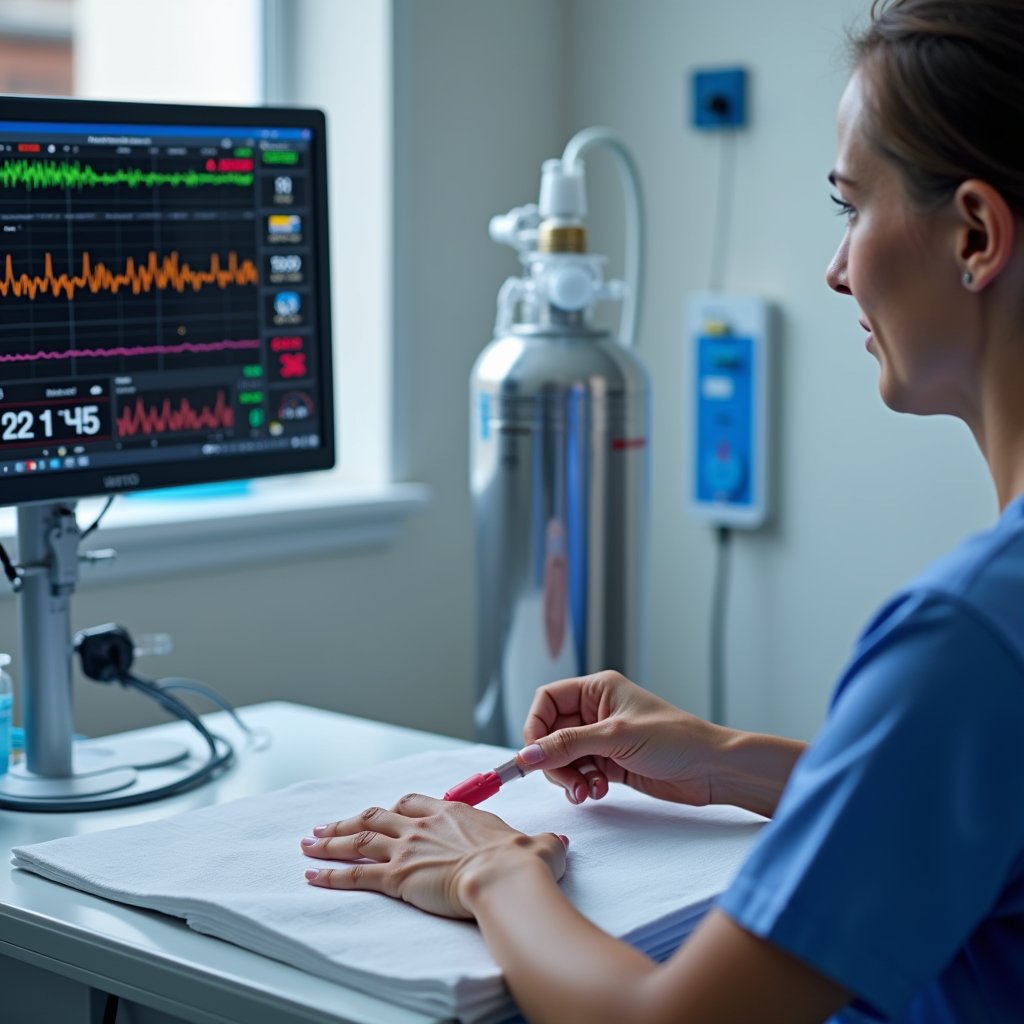Trauma patients can safely receive nitrous oxide when proper protocols are followed. You’ll need a 50:50 mixture with oxygen administered via demand valve systems, continuous monitoring of critical signs, and careful screening for contraindications like pneumothorax or head injuries. Studies show it’s effective for immediate PTSD symptom improvement and pain control during procedures, with two-thirds of patients reporting rapid relief. However, specific safety measures and patient selection criteria must be thoroughly understood before administration.
Understanding Nitrous Oxide in Emergency Medicine

While nitrous oxide has been a cornerstone of medical sedation for over a century, its role in emergency medicine continues to evolve through modern delivery systems and protocols. The drug’s nitrous oxide pharmacokinetics feature rapid onset within two minutes and quick clearance, making it suitable for brief emergency procedures. Studies show it is safe and effective during IV insertion and other emergency procedures.
Nitrous oxide’s rapid action and brief duration make it an invaluable emergency sedation option, building on decades of proven medical use.
You’ll find it’s typically administered as a 50/50 mixture with oxygen via demand valve systems, allowing patients to self-regulate their intake. Multiple studies, including research by Zier et al. analyzing 7,802 pediatric cases, have demonstrated consistent safety outcomes.
Patient selection criteria focus on identifying those who can safely receive treatment, excluding individuals with conditions involving trapped air or neurological deficits. When combined with local anesthetics, you’ll achieve ideal pain management, though the drug alone provides minimal analgesia.
The safety profile remains favorable, with mainly mild side effects like nausea and temporary disorientation, while maintaining stable hemodynamics and protective airway reflexes.
Key Benefits for Trauma Care

Although trauma care presents unique challenges in emergency medicine, nitrous oxide offers multiple evidence-based benefits that make it particularly valuable for these patients. You’ll find rapid symptom alleviation within hours of administration, with two-thirds of patients reporting immediate improvement in PTSD symptoms lasting up to one week. Treatment with 50% nitrous oxide and 50% oxygen mixture resulted in no serious mental health side effects in patients. Research shows that patients experienced intrusive thoughts dropped by more than half within 24 hours after treatment.
The 65% nitrous oxide/oxygen mixture provides superior pain control during procedures like burn wound dressing changes. Led by Dr. Peter Nagele, pioneering research continues to explore nitrous oxide’s potential for treating PTSD in military veterans.
Additionally, the treatment may disrupt trauma memory consolidation through NMDA receptor modulation, potentially preventing long-term PTSD development. The safety profile is particularly compelling, showing minimal impact on respiratory and cardiovascular systems during one-hour sessions.
Clinical trials demonstrate consistent efficacy patterns without dependency concerns, making it an excellent option for acute traumatic injuries in emergency department settings.
Safety Protocols and Administration Guidelines

You’ll need to maintain continuous essential sign monitoring and pulse oximetry while administering nitrous oxide to trauma patients, with particular attention to respiratory status and oxygen saturation levels.
The setup of demand-valve delivery systems requires verification of the fixed 50:50 nitrous-to-oxygen ratio and proper equipment calibration before patient use.
Your emergency response preparedness must include immediate access to resuscitation equipment and clear protocols for discontinuation if oxygen saturation drops below 90% or signs of respiratory distress emerge.
Monitoring During Nitrous Use
The safe administration of nitrous oxide requires thorough monitoring protocols across five key domains: physiological parameters, adverse effects, concentration control, environmental safety, and patient-specific factors.
You’ll need to implement a patient-centered care approach by continuously tracking critical signs, including pulse rate, blood pressure, oxygen saturation, and respiratory function. This multimodal approach involves vigilant observation for adverse effects like nausea, dizziness, and disorientation.
You must maintain strict concentration control through fixed 50% nitrous oxide/oxygen ratios while verifying delivery system integrity. Environmental safety demands proper ventilation and gas leak detection protocols.
Ultimately, conduct thorough patient-specific assessments, evaluating trauma type, respiratory status, and neurological condition before and during administration. These monitoring protocols guarantee safe nitrous oxide delivery while minimizing potential complications.
Proper Equipment Setup Guidelines
When establishing proper equipment setup for nitrous oxide administration, strict adherence to safety protocols guarantees excellent therapeutic outcomes while minimizing risks. You’ll need to verify proper ventilation requirements in the administration area and make certain all scavenging systems are operational before beginning setup.
| Equipment Component | Safety Requirement |
|---|---|
| Gas Mixture | 50:50 nitrous oxide/oxygen only |
| Delivery System | Self-administration mask with reservoir |
| Monitoring Device | Oximeter attachment mandatory |
| Emergency Backup | Accessible oxygen supply nearby |
Securing mask placement is critical verify all connectors are leak-free and the mask creates an adequate seal. You must validate the presence of a functional reservoir bag and proper gas flow before patient use. Remember to position emergency oxygen supplies within immediate reach and maintain continuous monitoring capabilities through attached oximetry devices.
Emergency Response Readiness
Establishing strong emergency response protocols remains critical for safe nitrous oxide administration in trauma settings. Your equipment management must include readily available emergency kits with reversal agents, though specific antidotes are limited. You’ll need to implement risk mitigation strategies through continuous respiratory monitoring and immediate response to any signs of adverse effects like dizziness, nausea, or disorientation.
When administering nitrous oxide, you must maintain strict exposure tracking and guarantee proper ventilation systems meet OSHA guidelines. If patients show signs of overdose or deterioration, you’ll need to discontinue treatment immediately and initiate emergency protocols. It’s essential that you continue monitoring patients for at least 30 minutes post-administration.
Your emergency response plan should also include clear protocols for alternative sedation methods when nitrous oxide is contraindicated.
Risk Assessment Before Treatment
Thorough risk assessment before nitrous oxide administration requires systematic evaluation of multiple patient-specific factors and contraindications. Your patient selection criteria must exclude ASA Class 4+ patients and those with severe systemic conditions that could compromise safety. An extensive risk stratification analysis should assess abdominal conditions, pneumothorax risk, and bleomycin exposure history.
You’ll need to verify the procedure’s suitability, ensuring it won’t exceed 30 minutes and warrants N2O use based on pain intensity. Screen for psychiatric conditions, chronic respiratory issues, and nutritional deficiencies, particularly vitamin B12 levels. Check for pregnancy status, as N2O is contraindicated during gestation. Document the patient’s previous N2O exposure within 24 hours and 7 days to prevent cumulative toxicity risks. Confirm their ability to follow breathing instructions and maintain adequate oxygenation.
Monitoring Requirements During Use
Safe nitrous oxide administration demands thorough physiological monitoring across multiple parameters. You’ll need to maintain continuous surveillance of critical signs while following established patient selection criteria and provider training requirements. This systematic approach guarantees early detection of adverse effects and ideal patient safety during sedation.
Track oxygen saturation, blood pressure, and respiratory rate at 3-5 minute intervals, with immediate response protocols for values outside normal ranges. Assess neurological status using standardized scales to monitor consciousness and detect over-sedation. Utilize capnography when available to evaluate ventilation adequacy and maintain appropriate CO₂ levels. Implement amplified monitoring protocols for high-risk cases, including trauma patients with head injuries or compromised respiratory function.
Potential Complications and Warning Signs
Critical complications of nitrous oxide administration in trauma patients manifest across four major physiological systems: respiratory, neurological, cardiovascular, and metabolic. You’ll need to monitor closely for warning signs that necessitate immediate contraindication management and dosing adjustments.
| System | Warning Signs | Required Action |
|---|---|---|
| Respiratory | SpO₂ <90%, increased work of breathing | Discontinue, provide 100% O₂ |
| Neurological | Agitation, slurred speech, focal deficits | Stop administration, assess GCS |
| Cardiovascular | SBP drop >20%, tachycardia | Fluid resuscitation, position change |
| Metabolic | Cyanosis, pallor, unexplained tachycardia | Check B12 levels, stop N₂O |
| Special Population | Persistent hypoxia, intractable vomiting | Immediate cessation, stabilize |
Recognize that certain conditions absolutely contraindicate nitrous oxide use, including pneumothorax, closed-head injuries, and severe cardiovascular instability.
Alternative Pain Management Options
Managing trauma pain effectively requires an extensive multimodal approach beyond nitrous oxide administration. By implementing a thorough pain management strategy, you’ll achieve superior outcomes through the synergistic effects of diverse interventions and medications.
Multimodal pain relief combinations heighten effectiveness by targeting different pain pathways simultaneously, such as combining acetaminophen with NSAIDs or integrating SNRIs with physical therapy. Patient education about non-opioid alternatives helps build acceptance of these modern pain control methods.
Topical analgesic options, including lidocaine patches and capsaicin preparations, provide localized relief with minimal systemic absorption.
Regional anesthesia techniques using ultrasound-guided nerve blocks deliver precise pain control while reducing opioid requirements.
Nonpharmacologic interventions complement medical approaches through exercise therapy, psychological support, and manual therapies, enhancing overall pain management outcomes while promoting functional recovery.
These evidence-based alternatives guarantee comprehensive pain control while minimizing potential complications.
Best Practices for Healthcare Providers
Before administering nitrous oxide, you’ll need to conduct a thorough patient assessment that screens for contraindications like B12 deficiency, bleomycin treatment history, and pregnancy.
During treatment, you must maintain continuous monitoring of pivotal signs while using standardized pain scales to evaluate the effectiveness of the 65% N₂O/O₂ mixture. You should keep antitussive agents readily available and maintain clear protocols for managing potential adverse reactions, including dizziness, nausea, or severe psychiatric responses.
Patient Assessment Before Administration
A thorough patient assessment forms the foundation for safe nitrous oxide administration in trauma care. You’ll need to evaluate multiple physiological and psychological factors while adhering to continuous monitoring requirements and implementing an exhaustive patient education process.
Assess respiratory status by checking oxygen saturation (must be >90%), evaluating COPD severity, and confirming adequate ventilation support capabilities.
Screen for absolute contraindications including head/neck trauma, pneumothorax, recent eye surgery, and bowel obstruction.
Evaluate cognitive function to confirm the patient can follow instructions, maintain proper breathing technique, and self-administer effectively.
Review medical history for critical factors such as bleomycin exposure, vitamin B12 deficiencies, and previous adverse reactions to nitrous oxide.
This systematic approach helps identify risks and confirms appropriate patient selection for safe nitrous oxide administration.
Monitoring During Treatment Protocol
Successful administration of nitrous oxide requires implementing detailed physiological monitoring protocols throughout the treatment period. You’ll need to track critical signs at specific intervals (T0, T1, T2, T3) using electronic manometers and pulse oximeters while maintaining continuous SpO2 monitoring. Document pain intensity using the NRS scale and correlate these scores with functional improvements.
Monitor oxygen saturation closely, discontinuing therapy if levels drop 2% below baseline. You must screen for adverse events like nausea, dizziness, and respiratory depression while ensuring proper patient education about potential side effects. Maintain thorough documentation of cylinder pressures, essential signs, and any interventions performed. This systematic approach enables effective follow-up assessment and helps evaluate treatment success while ensuring patient safety throughout the procedure.
Emergency Response Preparedness
Healthcare providers administering nitrous oxide must establish extensive emergency response protocols that address both routine complications and critical incidents. Proper resource allocation and personnel training are essential components of safeguarding patient safety during nitrous oxide administration.
You’ll need to implement a rapid response system for managing adverse reactions, including immediate access to emergency equipment and reversal protocols. Staff should be trained to watch for signs of subacute combined degeneration which can occur with nitrous oxide exposure.
You must guarantee all personnel receive thorough training in recognizing contraindications, particularly for patients with pneumothorax or head injuries.
You should establish clear communication channels between EMS providers and receiving facilities to coordinate patient handoffs and continuation of care.
You must maintain readily available emergency supplies, including pulse oximetry monitoring equipment and supplemental oxygen delivery systems, with regular equipment checks and maintenance schedules.
Latest Research and Clinical Evidence
Recent clinical studies investigating nitrous oxide’s therapeutic applications have yielded compelling evidence across multiple domains. Research demonstrates improved clinical safety when using portable delivery systems versus central piping, with personalized dosing strategies reducing adverse effects like nausea and vomiting. Healthcare facilities are increasingly encouraged to avoid centralized piping and instead use portable nitrous oxide tanks that remain sealed between uses. Current evidence shows that ozone depletion risks from medical nitrous oxide use remain significant. Studies show that patients report high satisfaction rates with nitrous oxide sedation compared to alternative agents during dental procedures.
You’ll find particularly remarkable results in PTSD treatment trials, where two-thirds of veteran participants experienced significant symptom reduction within 24 hours. However, response patterns vary considerably while some patients maintain relief for up to a week, non-responders typically revert to baseline within a day. The evidence supports nitrous oxide’s effectiveness in procedural sedation, especially in dental and pediatric settings, though practitioners increasingly favor alternative anesthetic methods to minimize environmental impact. Significantly, studies confirm no new-onset dissociative symptoms or psychosis among treated patients.
Frequently Asked Questions
Can Nitrous Oxide Be Used Alongside Local Anesthetics in Trauma Patients?
You can safely combine nitrous oxide with local anesthetics in trauma care, as they work through independent mechanisms without synergistic sedation. While you’ll need to examine patient comorbidities, there aren’t significant drug interactions between N2O and common local anesthetics.
You should maintain standard dosage limitations for both agents, but their complementary effects amplify pain management. The combination provides effective multimodal analgesia while preserving spontaneous breathing and airway reflexes.
How Long Should Patients Wait Before Driving After Nitrous Oxide Administration?
Wait at least 15-30 minutes after receiving nitrous oxide before considering driving. You’ll need to verify all effects have completely worn off and you’ve returned to normal alertness. Your recovery time depends on factors like dosage, individual metabolism, and whether other sedatives were used.
Side effects like dizziness or impaired coordination can persist briefly. For safety, it’s best to arrange alternative transportation or bring a companion who can drive you home after the procedure.
Does Nitrous Oxide Affect the Reliability of Neurological Assessments?
Yes, nitrous oxide greatly affects neurological assessment reliability. You’ll find that the drug temporarily impairs cognition and can conceal critical neurological signs.
While conducting assessments, you must account for its NMDA receptor antagonism effects, which alter mental status and coordination. The drug’s potential to cause respiratory depression can also confound neurological evaluations.
For accurate results, you should wait until the effects fully dissipate, typically 15-30 minutes post-administration.
Are There Special Considerations for Pediatric Trauma Patients Receiving Nitrous Oxide?
When administering nitrous oxide to pediatric trauma patients, you’ll need to implement special patient monitoring protocols and careful dosage titration. Start with lower concentrations (25-50%) and adjust based on the child’s response.
You must continuously evaluate their sedation level using validated scales and maintain SpO2 >90%. Be particularly cautious with premature infants and avoid use in cases of head injury, pneumothorax, or respiratory compromise.
Consider alternative sedation for major traumas.
What Is the Maximum Altitude at Which Nitrous Oxide Can Be Safely Administered?
You’ll need to ponder both altitude-related pressure effects and dosage considerations when administering nitrous oxide at elevation. While there’s no universal maximum altitude, most facilities restrict use above 5,000 ft (1,524 meters) due to gas expansion and equipment limitations.
You should avoid administration above 8,000 ft unless absolutely essential, as hypoxia risks increase greatly. Always verify your equipment’s altitude specifications and adjust flow rates accordingly.

